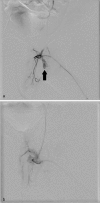Embolization Treatment of High-Flow Priapism
- PMID: 27582604
- PMCID: PMC5005085
- DOI: 10.1055/s-0036-1586152
Embolization Treatment of High-Flow Priapism
Abstract
Priapism is prolonged erection that persists beyond or is unrelated to sexual stimulation. There are two main types of priapism: high flow and low flow. The treatment of priapism will differ depending on the diagnosis of these two different types. In particular, interventional radiology plays a key role in treating patients with high-flow priapism. This article will review the diagnosis and treatment of the high-flow priapism.
Keywords: embolization; erectile dysfunction; interventional radiology; ischemic; nonischemic; priapism.
Conflict of interest statement
Figures

Similar articles
-
Interventional radiology: Diagnosis and treatment of post-traumatic nonischemic priapism: A case report.Radiol Case Rep. 2024 Jun 5;19(8):3533-3537. doi: 10.1016/j.radcr.2024.05.022. eCollection 2024 Aug. Radiol Case Rep. 2024. PMID: 38948900 Free PMC article.
-
Selective Penile Arterial Embolization Preserves Long-Term Erectile Function in Patients with Nonischemic Priapism: An 18-Year Experience.Urology. 2018 Dec;122:116-120. doi: 10.1016/j.urology.2018.07.026. Epub 2018 Jul 29. Urology. 2018. PMID: 30059714
-
Management of priapism: an update for clinicians.Ther Adv Urol. 2014 Dec;6(6):230-44. doi: 10.1177/1756287214542096. Ther Adv Urol. 2014. PMID: 25435917 Free PMC article. Review.
-
Priapism: current updates in clinical management.Korean J Urol. 2013 Dec;54(12):816-23. doi: 10.4111/kju.2013.54.12.816. Epub 2013 Dec 10. Korean J Urol. 2013. PMID: 24363861 Free PMC article. Review.
-
Diagnostic and therapeutic options for the management of ischemic and nonischemic priapism.Rev Urol. 2010 Winter;12(1):56-63. Rev Urol. 2010. PMID: 20428295 Free PMC article.
Cited by
-
Use of angioembolization in urology: a review.Transl Androl Urol. 2018 Aug;7(4):535-544. doi: 10.21037/tau.2018.05.12. Transl Androl Urol. 2018. PMID: 30211044 Free PMC article. Review.
-
The role of the urologist in managing high flow priapism.Int J Impot Res. 2025 Feb 5. doi: 10.1038/s41443-025-01017-6. Online ahead of print. Int J Impot Res. 2025. PMID: 39910241 Review.
-
[A bicycle fall with consequences].Urologie. 2023 Dec;62(12):1309-1314. doi: 10.1007/s00120-023-02202-5. Epub 2023 Oct 10. Urologie. 2023. PMID: 37816873 Free PMC article. German. No abstract available.
-
A rare case of post-traumatic high-flow priapism requiring endovascular salvage with bilateral superselective microcoil embolization.J Surg Case Rep. 2021 Mar 8;2021(3):rjab077. doi: 10.1093/jscr/rjab077. eCollection 2021 Mar. J Surg Case Rep. 2021. PMID: 33732429 Free PMC article.
-
What the radiologist should know about the role of interventional radiology in urology.Radiol Bras. 2019 Sep-Oct;52(5):331-336. doi: 10.1590/0100-3984.2018.0035. Radiol Bras. 2019. PMID: 31656352 Free PMC article.
References
-
- Broderick G A, Kadioglu A, Bivalacqua T J, Ghanem H, Nehra A, Shamloul R. Priapism: pathogenesis, epidemiology, and management. J Sex Med. 2010;7(1, Pt 2):476–500. - PubMed
-
- Roghmann F, Becker A, Sammon J D. et al.Incidence of priapism in emergency departments in the United States. J Urol. 2013;190(4):1275–1280. - PubMed
-
- Tay Y K, Spernat D, Rzetelski-West K, Appu S, Love C. Acute management of priapism in men. BJU Int. 2012;109 03:15–21. - PubMed
-
- Tripe J. Case of continued priapism. Lancet. 1845;2:1274–1276.
Publication types
LinkOut - more resources
Full Text Sources
Other Literature Sources

